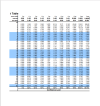Can I test standard deviation on a warm barrel or am I better off using a cold barrel because in most hunting situations the first shot will be a cold barrel??? How many shots to get an accurate standard deviation? I use a Lab Radar.
Can I test different loads standard deviation with just a few minutes between firings??
Thanks
TLDR: Lets stay real about single digit SD and shooting stats. Setting a realistic baseline expectation is difficult for a beginner because the internet is full of anonymous liars and not enough objective honest posters willing to share real stats.
This won't be a tutorial on statistics, but one or two points on your original list of questions quoted above.
You can test on a warm barrel, but that will represent that condition and the history on the barrel. However...
If you want cold bore, then no, you will need to test cold bore and include the cleaning and storage history conditions that matter to you between shots. Do you store your gun dirty or clean every time for example?
Does the gun get bounced around in a scabbard? Temp cycled into and out of hotel rooms or trucks? Lint or dirt in the barrel between shots?
When we are lucky, a hunting rig shoots the cold bore shot into the same group. Some rigs do not and there can be several reasons like the cleaning and storage conditions, or like in the case of rimfire if the ammo is wax lubed, etc..
If folks leave too much cleaning or preservative residue in the chamber or bore, it can cause a cold bore shift.
"How many shots?" On the order of 15 to 30 shots or more. The higher the scatter, the more shots it will take. The more process control problems you have, the more batch breaks you introduce, the more shots it will take...
Highly disciplined loading with a tight scatter can show a lower risk answer sooner.
"Can I test different loads standard deviation with just a few minutes between firings??" This is another "it depends" question. I would avoid it, but you can try. The issue is different powders and bullets versus your cleaning regimen. If those loads leave a residue that the next load doesn't like, then your data is affected.
I generally find jumping between copper solids and regular bullets means cleaning in between. Same issue with jumping between ball powders and stick powders in some instances. You will spend some shots to learn the ones you need to plan to clean between changes.
The cleaning between testing different bullets or recipes can have an effect. There is basic (chemical solvent) cleaning, and then there is scrub to bare barrel cleaning, and then there is also how many shots to stabilize the barrel after those points. Even the shot count on the barrel can change the issue comparing a fresh barrel to a worn barrel.
Being methodical with your testing includes being realistic about the type of gun and the type of shooter you are. A low experienced shooter, with a light carry gun is one extreme, and an accomplished high level shooter with a heavy accuracy rig is another. We should not expect similar baseline results.
I will take a risk of attracting flak for saying this, but unless you and your equipment are capable of tight scatter, then the shot count required to even detect a change can be so high that many folks mistakenly make the claim that some factors make no difference when in fact they do. You can often find that their guns and their shooting are the issue and that means taking more shots to get the stats to resolve the answer.
Shooters who boast or cherry pick their data don't do us any favors. Don't be unrealistic about your expectations when folks show you their "filtered" results instead of all their data.
Without being rude and uncivilized on the forums... when we take the extreme of a low experienced shooter with a low quality light carry gun, who makes claims that their baseline results are equal to those of a very accomplished shooter using state of the art gear, then we take it all with a grain of salt and don't fall for it. Too many folks are disappointed in their own stats but they are being unrealistic about their expectations when they baseline themselves at the wrong level.
I hear a lot of folks comment on shooting game at 1000 yards or more. I wasn't there and I would not call them out... however, I have pulled pits or spotted targets of all kinds, and worked with DoD and LEO folks of all kinds, and the first round hit percentages at 1000 yards on a cold bore without other shots with other guns in those same conditions... leave me with a lot of doubts.
A good rangefinder, and climate data from things like a Kestrel help improve the percentages, but even the most accomplished shooters are not close to 100% out in the field at those distances from a cold bore.
No wind flags, no sighters, no way to know cross canyon winds, etc., etc., means that it takes bluebird conditions, state of the art gear, and an accomplished shooter, to call it ethical. "Know thyself" is ancient wisdom that applies to shooting and hunting ethics. YMMV.

